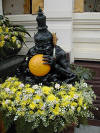|
Rahu (राहु, ราหู)
Sanskrit-Thai.
The god of darkness, a legless demon who causes the eclipses of the
sun and moon. After the churning of the
Ocean of Milk this demon
surreptitiously sneaked in the row among the gods and received a portion of the
amrita, reserved only for the gods and excluding the troublesome demons who are deemed the cause of much human misery.
Surya, god of the sun, and
Chandra, god of the moon, uncovered
this deceit and reported it to
Vishnu who immediately cut the demon in two
with his discus -in some texts it is
Indra who cut Rahu in two
with his thunderbolt- however, the amrita had already taken its effect and both
parts lived on separately. As immortal beings they took their place among the
stars where
Ketu, the lower part of Rahu
representing the tail, personifies comets and meteorites and the upper part of Rahu travels through the universe in a chariot
pulled by eight black horses. Because he never forgot the betrayal by the sun
and the moon he continuously chases them with his mouth open. When he swallows one or the other
of them he causes the eclipses, though because
he has no underside anymore they keep falling out thus ending the eclipse. Rahu is
also one of the nine gods who are worshipped in the
Phra prajam wan system of the Hindus (fig.).
He is situated on the Southwest, facing South, whereas Ketu the personification of his
tail, is placed behind him (fig.).
Tantra Thewala, i.e. the ‘Tantra
Idol Shrine’, which is also known as
Wat Phra Siwa Chao, i.e. the
‘Lord
Shiva Temple’, in
Bangkok, has a statue of the demon Rahu standing on
Garuda, prior to losing his legs (fig.).
Rahu is also
known for creating the darkness of black and ominous clouds to help conceal
Ramasoon,
the god of thunder
(fig.)
in order to try and capture the nymph
Mekala
(fig.).
He is often depicted together with
Tao
Ramathep (fig.).
Sometimes transcribed Rahoo. Compare with the Burmese demon
balu,
especially with the
iconographic
style
balu pan gai
(fig.)
and with the
Sanskrit term
kirtimukha
(fig.), as well as the Chinese ogre
Taotie (fig.). See also
Wat Samaan Rattanaraam, a temple that houses a gigantic statue of Rahu,
said to be the
largest in Thailand (fig.), and
Jatukam-Ramathep. Rahu is sometimes referred to as Bhayanaka and as the god of change. His consort is known as Karali. WATCH VIDEO.
回






|

